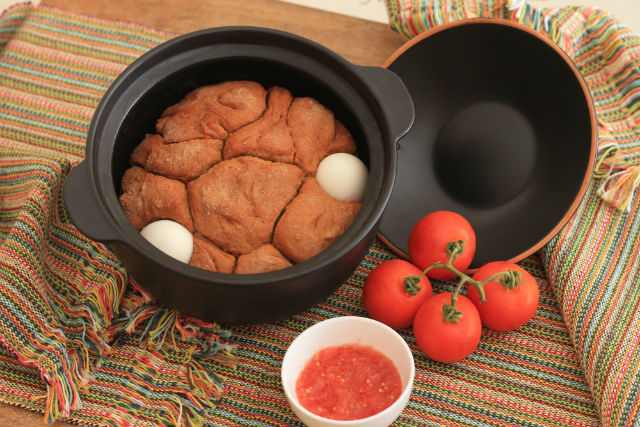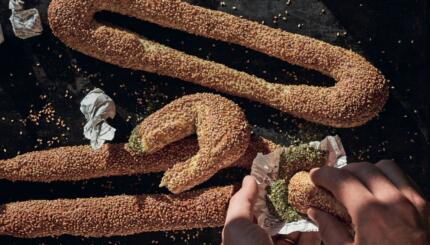Though the official tally on Shabbat meals is three (Friday night dinner, Shabbat day lunch and the third meal on Saturday at dusk called the third meal, or seudah shlishit) some people like to add a breakfast. The reason for this is largely practical. Though sleeping in on Shabbat has a certain loveliness and in many places synagogue services only begin at nine, to accommodate the sleepers, the most pious Jews rise for prayer at dawn. In Jewish law this is regarded as optimal, as morning worship is timed to coincide with the rising of the sun. When those early birds come back from synagogue they are hungry but not necessarily ready to tuck into cholent at eight o’clock in the morning—hence the emergence of the Shabbat morning kiddush/ breakfast. This meal can be as simple as a glass of wine or shot of whiskey and a cookie or as elaborate as the Yemenite kiddush of kubaneh or the Sephardi desayuno, an elegant dairy brunch featuring a variety of fresh salads, cheeses and pastries.
The Jews of Yemen would assemble a buttery, yeast dough on Friday afternoon, leaving it overnight to bake so that it could be warm and fluffy for a post-services breakfast. Kubaneh can be enjoyed with a simple grated tomato dip.
These recipes are excerpted from Carol Ungar’s new book Jewish Soul Food: Traditional Fare and What It Means.
Love Jewish food? Sign up for our weekly Nosher recipe newsletter!
The Nosher celebrates the traditions and recipes that have brought Jews together for centuries. Donate today to keep The Nosher's stories and recipes accessible to all.
Ingredients
7-8 cups all-purpose flour
1 Tbsp dry yeast (25 grams)
1 Tbsp salt
3 cups water (approximately)
3 Tbsp sugar
⅔ cup butter or margarine, softened (the original recipe used ghee which is clarified butter)
4 whole tomatoes
salt and pepper
Directions
Combine all ingredients except for margarine (or butter). Slowly add water.
Knead the dough it should be soft and sticky. Cover dough and leave to rise (rising times depends on weather. In the summer it can rise in under an hour.)
Punch down and let rise. Punch down a second time. Let rise once again.
Divide dough into eight balls. Cut margarine or butter into eight pieces. Roll each dough ball flat so that it resembles a pita. Insert a ball of margarine in the center and fold dough around in the shape of a ball. Grease the walls in a large oven proof pot and place dough balls inside. The dough should fit half the pot, so that there is plenty of room to rise.
Leave the dough for another hour to rise.
Cover with lid. Some people cover the whole pot with heavy duty aluminum foil.
Bake for thirty minutes at 180° C or 350° F. Lower heat to 110° C or 230° F and bake overnight.
To make the tomato dip: Peel four tomatoes (you can poach them in boiling water and then peel or just peel with a knife).
Grate tomatoes with salt and pepper to taste. Serve with kubaneh.
cholent
Pronounced: CHO-lent, Origin: Yiddish, but believed to be derived from French, a slow-cooked stew traditionally prepared for and left cooking over Shabbat.
Shabbat
Pronounced: shuh-BAHT or shah-BAHT, Origin: Hebrew, the Sabbath, from sundown Friday to sundown Saturday.



